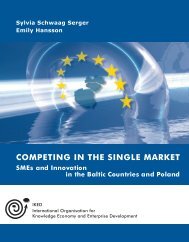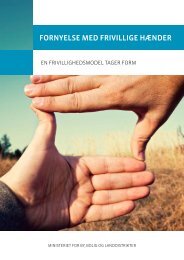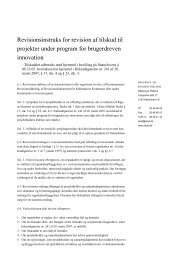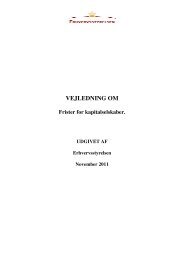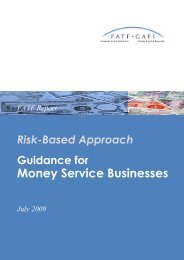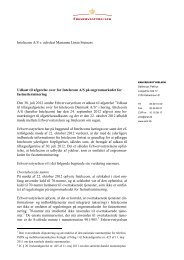The Bio-Health Industry in Denmark - Erhvervsstyrelsen
The Bio-Health Industry in Denmark - Erhvervsstyrelsen
The Bio-Health Industry in Denmark - Erhvervsstyrelsen
Create successful ePaper yourself
Turn your PDF publications into a flip-book with our unique Google optimized e-Paper software.
<strong>The</strong> ChallengeThroughout the world the bio-health <strong>in</strong>dustry is one of the fastest grow<strong>in</strong>gand most wealth creat<strong>in</strong>g <strong>in</strong>dustries today. <strong>The</strong> potential of this <strong>in</strong>dustryis substantial <strong>in</strong> job creation, <strong>in</strong>novation and growth. However, on a globalscale competition is fierce. <strong>The</strong> grow<strong>in</strong>g bio-health <strong>in</strong>dustry is geographicallyclustered <strong>in</strong> certa<strong>in</strong> countries and regions and many strive to attractthis rich source of taxable wealth.<strong>The</strong> challenge for Europe – and <strong>Denmark</strong> – is huge. Today America is wellahead of Europe and the gap <strong>in</strong>creases. US public expenditure <strong>in</strong> bio-healthresearch is rapidly grow<strong>in</strong>g. Even though 2000 was the best year yet forEuropean biotechnology, the USA <strong>in</strong>creased its lead. While Europe has nowmore biotechnology companies than the USA, Europe produces fewer products,employs fewer people and has less f<strong>in</strong>ance to develop the <strong>in</strong>dustry.Moreover, still more European bio-health companies place <strong>in</strong>vestments <strong>in</strong>the US where bus<strong>in</strong>ess conditions are judged to be more favourable.Europe has to develop a thriv<strong>in</strong>g bio-health <strong>in</strong>dustry if the goals ofeconomic competitiveness set at the Lisbon meet<strong>in</strong>g <strong>in</strong> 2000 are to befulfilled. Recognis<strong>in</strong>g this the Commission of the European Union hasprepared an overall life sciences and biotechnology strategy for Europe,which was agreed upon by the EU m<strong>in</strong>isters at the Barcelona Summit <strong>in</strong>March 2002.<strong>The</strong> life sciences and biotechnology strategy will only be realised if themember states and regions take the right decisions.<strong>Denmark</strong> – particularly Medicon Valley – has a strong potential to becomeone of the lead<strong>in</strong>g bio-health regions <strong>in</strong> Europe <strong>in</strong> the fields of medic<strong>in</strong>es,biotechnology and medical devices, <strong>in</strong>clud<strong>in</strong>g IT and electronics. OtherDanish regions will benefit from growth <strong>in</strong> Medicon Valley. Thus, <strong>Denmark</strong>as a whole can benefit from an <strong>in</strong>creas<strong>in</strong>g European focus on biotechnologyat the same time as <strong>Denmark</strong> can contribute substantially to fulfill<strong>in</strong>gthe European objectives.<strong>The</strong> <strong>Bio</strong>-<strong>Health</strong> <strong>Industry</strong> <strong>in</strong> <strong>Denmark</strong> 3
Benchmarks<strong>The</strong> follow<strong>in</strong>g set of benchmarks is proposed <strong>in</strong> order to establish amonitor to measure the progress towards the vision <strong>in</strong> 2010 so correctiveaction can be taken if targets are not met.• Wealth creation<strong>The</strong> value added per employee <strong>in</strong> the Danish bio-health <strong>in</strong>dustry must atleast be at the same level as the value added per employee <strong>in</strong> thebio-health <strong>in</strong>dustry <strong>in</strong> compet<strong>in</strong>g regions/countries.• Job creation<strong>The</strong> rate of job creation <strong>in</strong> the Danish bio-health <strong>in</strong>dustry shouldsurpass the rate of job creation <strong>in</strong> the bio-health <strong>in</strong>dustry <strong>in</strong> compet<strong>in</strong>gbio-health regions/countries.• Labour supplyHighly skilled labour at all levels relevant to the Danish bio-health<strong>in</strong>dustry should be available at least by the same volume as to thebio-health <strong>in</strong>dustry <strong>in</strong> compet<strong>in</strong>g countries/regions.• Exports<strong>The</strong> growth rate <strong>in</strong> Danish bio-health <strong>in</strong>dustry exports must exceedthe growth rate <strong>in</strong> bio-health <strong>in</strong>dustry exports of compet<strong>in</strong>gregions/countries.• Entrepreneurship<strong>The</strong> new company growth rate <strong>in</strong> the Danish bio-health <strong>in</strong>dustry mustoutreach the new company growth rate <strong>in</strong> the bio-health <strong>in</strong>dustry <strong>in</strong>compet<strong>in</strong>g regions/countries.<strong>The</strong> <strong>Bio</strong>-<strong>Health</strong> <strong>Industry</strong> <strong>in</strong> <strong>Denmark</strong> 5
10 Key Recommendations1. Build<strong>in</strong>g on exist<strong>in</strong>g cluster strengths• All bio-health regions are dependent on geographically close <strong>in</strong>teractionamong <strong>in</strong>dustry, universities and hospitals. <strong>The</strong> Danish bio-healthstrategy must acknowledge and build on regional competencies alreadyobta<strong>in</strong>ed. In Medicon Valley, the successful results of the past decadecalls for an expansion of the bio-region <strong>in</strong> terms of labour supply,research co-operation, technology transfer, capital market and <strong>in</strong>frastructure.To ensure future growth the Vision Round Table recommends<strong>in</strong>creas<strong>in</strong>g <strong>in</strong>vestments <strong>in</strong> R&D and <strong>in</strong>frastructure <strong>in</strong> Medicon Valley.Regulatory barriers for work force mobility <strong>in</strong> the region should beremoved. In other Danish regions, local competencies <strong>in</strong> universities andcompanies should be further developed <strong>in</strong> various and potentiallyprosperous niches of the expand<strong>in</strong>g bio-health <strong>in</strong>dustry by comb<strong>in</strong><strong>in</strong>g,e.g., electronics, medical devices and <strong>in</strong>formation technology withhealth care.• Due to <strong>Denmark</strong>’s size it is necessary to strengthen <strong>in</strong>ternationalco-operation between regions, especially concern<strong>in</strong>g labour supplyand research. It is vital to have bra<strong>in</strong> circulation with other countriesto ensure a critical mass of highly skilled personnel. Special attentionshould be given to the potential for collaborations with<strong>in</strong> theScand<strong>in</strong>avian-Baltic region.2. Competitive public fund<strong>in</strong>g of world class research• Research <strong>in</strong>vestments are long-term <strong>in</strong>vestments that should not beneglected <strong>in</strong> the light of short-term fiscal problems. Investments mustbe targeted on the excellent researchers and research groups – and notevenly spread.• In comparison to the compet<strong>in</strong>g countries/regions <strong>Denmark</strong> haspreviously been a late arriver when it comes to research <strong>in</strong>vestments. Itis therefore important that public research <strong>in</strong>vestments are deployedearlier <strong>in</strong> new scientific fields that rest on exist<strong>in</strong>g pillars of strength.<strong>The</strong> <strong>Bio</strong>-<strong>Health</strong> <strong>Industry</strong> <strong>in</strong> <strong>Denmark</strong> 7
Multidiscipl<strong>in</strong>ary research comb<strong>in</strong><strong>in</strong>g biotechnology with other technologiessuch as, e.g., nano-, <strong>in</strong>formation- and materials technologiesshould be a high priority <strong>in</strong>vestment area.• Danish universities compete not only with each other but also with thebest European and other foreign universities. Research <strong>in</strong>vestmentsshould therefore be based on assessments of the capacity of the universitiesto excel <strong>in</strong> science and education. Universities should compete forresources <strong>in</strong> order to ensure excellence <strong>in</strong> research teams.• <strong>The</strong> future Danish research priorities for the bio-health area should bemore aligned with the EU 6th Framework Programme <strong>in</strong> order to attractmaximum fund<strong>in</strong>g.3. More <strong>in</strong>dustrial co-f<strong>in</strong>anc<strong>in</strong>g of public research• <strong>Industry</strong> should <strong>in</strong>crease co-f<strong>in</strong>anc<strong>in</strong>g of research projects, GraduateSchools of Research etc. at public <strong>in</strong>stitutions of <strong>in</strong>dustrial <strong>in</strong>terest.• <strong>The</strong> public sector should support <strong>in</strong>dustrial co-f<strong>in</strong>anc<strong>in</strong>g by develop<strong>in</strong>gmodels for co-f<strong>in</strong>anc<strong>in</strong>g of a simple and transparent character whilesafeguard<strong>in</strong>g the <strong>in</strong>dependence of research.4. Modernis<strong>in</strong>g university management• University management must be strengthened. University managershold<strong>in</strong>g key university positions should have the necessary managementtools, i.e. ability to prioritise resource allocation, <strong>in</strong>clud<strong>in</strong>g the tools topromote successful projects. University management structure shouldbe changed, so the govern<strong>in</strong>g board of the university has a majority ofexternal members.• New research <strong>in</strong>vestments should favour universities with a dynamicand efficient university management system. <strong>The</strong> fund<strong>in</strong>g system forresearch should be simplified once the university management ismodernised at all universities. <strong>The</strong> exist<strong>in</strong>g two-tier system for allocationof research funds (i.e. through universities and through ResearchCouncils) should be ma<strong>in</strong>ta<strong>in</strong>ed.<strong>The</strong> <strong>Bio</strong>-<strong>Health</strong> <strong>Industry</strong> <strong>in</strong> <strong>Denmark</strong> 8
5. Strengthen<strong>in</strong>g the partnerships between <strong>in</strong>dustry andresearch <strong>in</strong>stitutions• <strong>The</strong> partnerships between universities, hospitals and the bio-health<strong>in</strong>dustry on research, jo<strong>in</strong>t tra<strong>in</strong><strong>in</strong>g and competence development mustbe further strengthened. <strong>The</strong> Industrial Ph.D. Fellowship Programmeshould be promoted as a simple and efficient mechanism of technologytransfer. Other simple mechanisms for co-f<strong>in</strong>anc<strong>in</strong>g Ph.D.s should alsobe explored, for <strong>in</strong>stance co-f<strong>in</strong>anc<strong>in</strong>g through Graduate Schools ofResearch.• In order to strengthen the commercialisation of patents <strong>in</strong>vestments<strong>in</strong> Technology Transfer Offices should be made at all universities. Suchoffices constitute potential new sources of revenue for the universitiesand thus represent a strategic tool for university managements.Technology Transfer Offices should be professionalised as they are <strong>in</strong>USA. Technology Transfer Offices should therefore be established <strong>in</strong>co-operation with organisations that have competencies <strong>in</strong> this field,e.g. foreign firms.• A model for shar<strong>in</strong>g the benefits of <strong>in</strong>ventions, devised so as to give<strong>in</strong>centives to all stakeholders, should be <strong>in</strong>troduced at all universities.Such a model should ensure that both the <strong>in</strong>ventor and the departmentreceive a substantial part of the profit.6. Expand<strong>in</strong>g the supply of skilled labour• It is vital for the cont<strong>in</strong>ued progress of the bio-health <strong>Industry</strong> to havean adequate supply of a skilled work force at all qualification levels. Atthe present the bio-health <strong>in</strong>dustry feels a shortage of skill supply <strong>in</strong>various fields, e.g. Ph.D.s. Crucial skills at graduate and Ph.D. level arechemistry, biochemistry, bio<strong>in</strong>formatics, physics, eng<strong>in</strong>eer<strong>in</strong>g, datamanagement pharmaceutical sciences and cl<strong>in</strong>ical development.<strong>The</strong> <strong>Bio</strong>-<strong>Health</strong> <strong>Industry</strong> <strong>in</strong> <strong>Denmark</strong> 9
9. Flexible public regulation <strong>in</strong> product development• A flexible and fast work<strong>in</strong>g public regulatory system for the developmentof medic<strong>in</strong>es and devices is a fundamental framework conditionfor all bio-health clusters. It is therefore important that <strong>Denmark</strong>ma<strong>in</strong>ta<strong>in</strong>s and develops a public regulatory system cover<strong>in</strong>g all aspectsof the development and approval processes (ethical committees,reimbursement and market<strong>in</strong>g approvals etc.), which is among themost efficient <strong>in</strong> Europe.• With regard to the approval of medic<strong>in</strong>es and products transparency ofprocedures, good review ability and will<strong>in</strong>gness to give <strong>in</strong>formal op<strong>in</strong>ionare decisive factors for <strong>in</strong>dustry. <strong>The</strong> Danish Medic<strong>in</strong>es Agency shouldsecure solid basic expertise <strong>in</strong> the fields of toxicology and cl<strong>in</strong>ical trialsand the field chemistry, manufactur<strong>in</strong>g and control (CMC). Furthermore,the Danish Medic<strong>in</strong>es Agency should develop world class expertise<strong>in</strong> other selected areas <strong>in</strong> partnership with research <strong>in</strong>stitutions andprivate companies <strong>in</strong> order to operate on an <strong>in</strong>creas<strong>in</strong>g competitiveEuropean market for approval of medic<strong>in</strong>es and products.• <strong>The</strong> three university hospitals’ Good Cl<strong>in</strong>ical Practice procedures shouldbe harmonised <strong>in</strong> order to secure the best conditions for mobility ofresearchers and students.10. Well-<strong>in</strong>formed public perception• A well-<strong>in</strong>formed public op<strong>in</strong>ion is an important condition for the furtherdevelopment of the bio-health <strong>in</strong>dustry. <strong>The</strong> responsibility for thedissem<strong>in</strong>ation of <strong>in</strong>formation rests with the public sector as well asthe private sector. <strong>The</strong> ongo<strong>in</strong>g government <strong>in</strong>itiative to promote opennessand debate on bioethics is important and should be cont<strong>in</strong>ued.Furthermore, the government should <strong>in</strong>form, stimulate and qualify thedebate <strong>in</strong> new areas of ethical <strong>in</strong>terest. Companies should contribute byenhanc<strong>in</strong>g transparency and by <strong>in</strong>form<strong>in</strong>g the public on ethical issues.F<strong>in</strong>ally, the ethical discussion should not be conf<strong>in</strong>ed to biotechnology. Itis the application of biotechnology – and other technologies – and notmerely the technology <strong>in</strong> itself that may give rise to ethical questions.<strong>The</strong> <strong>Bio</strong>-<strong>Health</strong> <strong>Industry</strong> <strong>in</strong> <strong>Denmark</strong> 12
August 2002National Agency forEnterprise and Hous<strong>in</strong>gDahlerups PakhusLangel<strong>in</strong>ie Allé 17DK-2100 København ØTel. (+45) 35 46 60 00www.ebst.dkErhvervslivets Hotl<strong>in</strong>eTel. (+45) 35 46 66 66<strong>The</strong> <strong>Bio</strong>-<strong>Health</strong> <strong>Industry</strong> <strong>in</strong> <strong>Denmark</strong> 13





